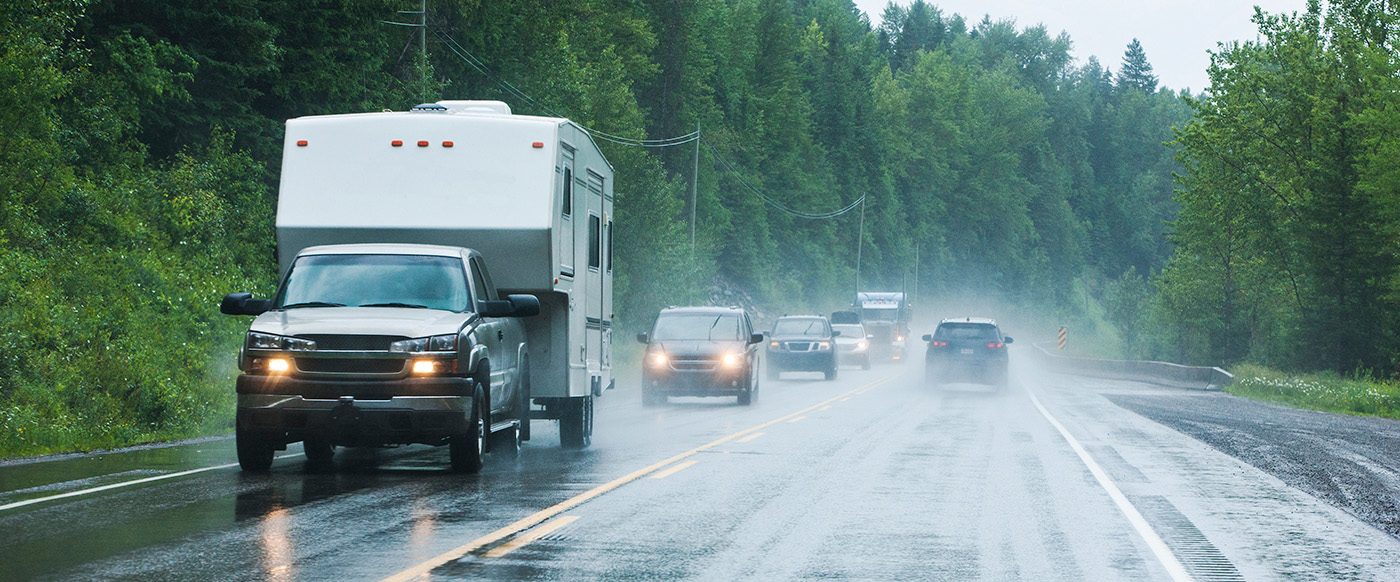10 tips for driving safely in heavy rain
11/21/2022Our priority at BCAA is to help protect our province and everyone that lives within it, so here are 10 top tips for safe driving in inclement weather:
- Slow down. Rule number one is the simplest and easiest. Wet roads make it slippery for even the best-performing tires. Take your time and lower the risks of an accident.
- Steer clear of potholes. When potholes are filled with water, it’s very hard to know how deep they are. If you can’t avoid running into a pothole, at least make sure you don’t brake when your wheels hit it. Deep potholes filled with water can flood an engine and cause damage, even from the excessive splashing when you drive through a puddle.
- Keep your distance. Respect the three-second rule with respect to the car ahead of you. Pick a reference marker and when the other car passes it, you must be able to count “one thousand and one, one thousand and two, one thousand and three” before you pass the same marker. For very bad conditions, keep counting: “one thousand and four, one thousand and five, one thousand and six.” This way, in an emergency, you’ll have more time to react and stop or avoid an incident.
- Make sure your tires are in good condition. A thorough inspection will reveal any cracks, foreign matter or unequal wear. Check the tire pressure every month, and keep your tires inflated according to the manufacturer’s recommendations. Remember: an under-inflated tire will wear out faster, increase your fuel consumption, and fail to channel away water properly.
- Turn off the cruise control. Hydroplaning is when your vehicle slides uncontrollably on the wet surface of a road. If your wheels start hydroplaning, your first reflex—and it’s the correct one—would normally be to take your foot off the gas. If the cruise control is on, it will detect a loss of power and attempt to compensate. The result will be a sudden acceleration, which is the last thing you want.

- Lower the risk of hydroplaning. If there are noticeable ruts down the middle of the highway, shining in the rain, avoid driving in them, even if it means staying a little off-centre in your lane.
- Be careful when stopping. When driving in the city, danger lurks at intersections where leaked vehicle fluids can practically turn the road surface into a skating rink. Be alert. When approaching a stop sign or red light, brake sooner and more gently than usual.
- Make sure you can be seen. Your daytime running lights aren’t enough in the rain. Depending on vehicle makes and models, the taillights don’t always come on at the same time. You should turn on your headlights and taillights to make sure you’re visible to drivers both in front and behind you—even in daylight.
- Make sure your tires and windshield wipers are in good shape. Having your tires in good condition is crucial to ensuring safe gripping and handling on wet roads. Some tires are more suitable for heavy rain than others. Our team of trusted auto experts at BCAA Auto Service Centres can provide you with the information you need to choose the right tires for your needs.
Book an appointment at one of our four BCAA Auto Service Centre locations in Nanaimo, Victoria, Kelowna and South Surrey where you'll always get honest auto service advice.
Wipers should be replaced annually as the rubber dries out. Dried wiper blades can skip or chatter and leave streaks that will impair your ability to see clearly. A properly cleaned window can also help. Try not to use wipers to defrost or wipe the windshield on start up because any ice, grit or dirt can deteriorate the wipers. If it’s freezing cold, stand the wipers up when you get home so they don’t freeze to the glass. Starting the wipers when frozen to the window can damage the mechanism that moves them. - If visibility gets poor then stop. If it’s raining so hard that your vision is impaired to the point that driving becomes dangerous, choose a safe place to pull off the road. If you’re on the highway, try to get to the next rest area. Otherwise, park on the shoulder as far as possible from the roadway.

Your BCAA Membership comes with 24/7 Roadside Assistance, so we’re always here to help in case of the unexpected. You can request BCAA Roadside Assistance online or via the BCAA Mobile App for Android or iPhone to connect directly to our dispatch team.
Your BCAA Mobile App is the ultimate travel companion. In addition to helping you get faster access to Roadside Assistance, you can get real-time travel conditions and savings from BCAA Rewards Partners along the way. Learn more about how to get the most out of your BCAA Mobile App.







